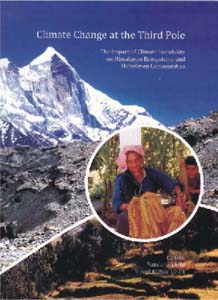Annals of Neurosciences, Vol 17, No 1 (2010)
Annals of Neurosciences, Volume 17, Number 1, January 2010
Impact of Climate Instability

Climate Change at the Third Pole
Published by Navdanya & Research Foundation for Science, Technology & Ecology
Price :Rs. 1200.00
Pages : 223
Reviewed by Arvind Kr. Bhatt & Sanjay Verma
“Climate Change at the Third Pole” (The Impact of climate Instability on Himalayan Ecosystems and Himalayan Communities): Edited by Vandana Shiva & Vinod Kumar Bhatt and Published by Navdanya & Research Foundation for Science, Technology & Ecology (RFST&E), Dehradun, Uttarakhand (India), pp 223, price Rs. 1200/- & Rs.750/-(paper back).
Climate of our planet is changing. The climate has always been variable, but there appears to be a growing concern over the climatic changes due to the frequency of natural disasters and the quantum of seasonal shifts. The climate dynamics seems to be unprecedented in the contemporary world, significantly because there is strong evidence to suggest that humanity is, by and large, directly responsible for climate changes. The impending threat to our planet can no more be ignored since this phenomenon has jeopardized not only natural resource conservation and sustainability of socio-economic systems but has threatened the very life-support system, no doubt adversely impacting world’s natural and cultural heritage. Economic developments coupled with population growth are likely to be in all probability will influence the climate change and the ruralurban livelihood. Extensive efforts are being made worldwide to understand the anthropogenic impacts on climate of the planet and establish linkages with livelihood and food security. International bodies like Intergovernmental Panel on Climate Change (IPCC), WMO, UNEP, USEPA, UNFCCC, ICIMOD and several others have come up with several reports indicating the consequences if humanity continues to behave the way it presently is and do not make any effort to cultivate change in attitude and lifestyle. This book is of immense importance, as it provides factual and well researched insight to the crucial aspects of climate change, peculiar to the Himalayas.
The information provided in the document, in our view, is extremely relevant at a time when there are too many controversial opinions on the ecological impacts. The researchers will be benefitted and will enable the Governments across the globe for combating climate change and planning action time lines. The Govt. of India, in particular, can draw inferences for effectively carrying forward its “National Mission on Himalayan Ecosystems”.
The Book comprising of total 12 Chapters is objectively divided into four parts and contains useful ‘Scientific Recommendations’ for policy initiatives on Climate Change Mitigation and Adaptation in the Himalayan Region. Part-I (Chapter-1) gives an overview of the Himalayan Ecosystems and Climate Change. Part-ll (Chapters 2 & 3) inter-alia contains the findings of the Navdanya’s participatory study reports in Uttarakhand and Ladakh relating to the impact of climate change on the ‘livelihoods’ and the ‘Impact Analysis’. The status of Glaciers and Rivers in the Himalayan Region is given in Part-III (Chapters 4-7) which includes an Overview of Glacier Retreat in Indian Himalayas, Status Report on Glaciers of Ladakh, J&K and India, Impact of climate change on rainfall, snowfall, temperatures, food crops, cloudbursts, water resources, forests and initiatives in Himachal Pradesh, and also, as to how the Tibetan Plateau is experiencing the vagaries of climate change. Part-IV (Chapters 812) dedicated to the impact of climate change on Biodiversity and Agriculture provides factual data on mountain agriculture, adaptation potentials, preliminary studies of Uttarakhand Biodiversity, significance of organic agriculture, and adaptive strategies of the mountain farmers besides few case studies.
The authors have also meticulously incorporated the People’s Charter on Climate Change for North-West Himalaya with signatories from 165 villages of 5 River Valleys of Uttarakhand, 22 villages of 3 Valleys of Ladakh and the people who participated in the Regional Conference at Leh and Dehradun organized by Navdanya. The Scientific Recommendations provided at the end of the Book are based on the researched data, reports, people’s participation and scientific inputs. The People’s Charter and Scientific Recommendations which give details of the strategies for Agriculture, Forest & Biodiversity, Water, Energy and Environment can be effectively put to use for planning future strategies in consideration of the difficult Himalayan topography and agrarian populace. The cover design is excellent, matching with the theme of publication, the layout, overall presentation and printing and the organisation of Chapters is also carefully done. The authors deserve a special appreciation for the same.
Hon’ble Union Minister for Environment & Forest, Govt. of India, Sh. Jairam Ramesh in his ‘Forward ’ has complimented the authors and the editors for the well researched and useful document. Besides, the Padma Vibhushan Sh. Sunder Lai Bahuguna and Prof. Samdhong Rinponche Kalon Tirpa, Central Tibetan Administration have also lauded the efforts of the editors and authors.
doi: 10.5214/ans.0972.7531.2010.170112
Arvind Kumar Bhatt
Principal Scientific Officer-Biotechnology
Government of Himachal Pradesh,
Shimla-171 002, HP (India)
E-Mail: bhtarvind@yahoo.com
Sanjay Verma
Project Officer
Department of Environment, Science & Technology
Govt, of Himachal Pradesh, Shimla-171 002, HP (India)
E-Mail: envispl@yahoo.co.in
(c) Annals of Neurosciences.All Rights Reserved